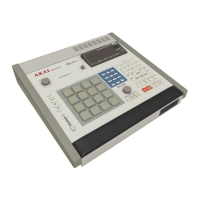Section 4:Editing sequences 107
used (described in section 6.9), many of these events are recorded
into the active track to simulate a smooth and continuous mixer
volume change. There are two fields: DRUM (which of the 32
drums this event applies to) and VAL (the new mixer setting, 0 -
127).
1>O1-Mix Pan> Drum:TOM4 Val: 127
This is a MIX PAN event, and is used to change the stereo
mixer pan setting of a particular drum in mid-sequence.
When the RECORD LIVE CHANGES feature is used
(described in section 6.9), many of these events are recorded
into the active track to simulate a smooth and continuous
mixer pan change. There are two fields: DRUM (which of
the 32 drums this event applies to) and VAL, the new mix pan
setting, from 0 (fully left) to 127 (fully right).
>O1-Echo Volume> Drum:PRC2 Val: 127
This is an ECHO VOLUME event, and is used to change the echo
mixer volume setting of a particular drum in midsequence. When
the RECORD LIVE CHANGES feature is used (described in
section 6.9), many of these events are recorded into the active track
to simulate a smooth and continuous echo mixer change. There are
two fields: DRUM (which of the 32 drums this event applies to)
and VAL (the new echo mix setting, 0 - 127).
1>01-SysEx> Size:999 Byte:999 Val: 127
This is a SYSTEM EXCLUSIVE event. It represents any system
exclusive message. There are three fields: SIZE (the total number
of data bytes), BYTE (the number of the byte whose contents are
currently displayed in the Val field) and VAL (the current value of
the byte number displayed in the BYTE field). The maximum size
of a system exclusive event is 999 bytes.
Of the five on-screen events, only the uppermost line may be edited, and is
edited by moving the cursor to the desired field within the line and editing
the field contents. This uppermost line is called the "active event" and is
preceded by a ">". To edit an event, it must be moved up to the active event
line using the CURSOR UP and CURSOR DOWN keys. This procedure is
described below.
To move to different locations within the sequence, use the "<" or ">"
keys to move backward or forward one step, and the “<<" or ">>” keys
to move backward or forward one bar, just as in the PLAY/RECORD
screen. As with the PLAY/RECORD screen, the size of the step is
determined by the NOTE VALUE field in the TIMING CORRECT
screen. It is most commonly set to a 1/16 note.
As you move through the sequence to each new step (usually one 1/16
note) by pressing the "<" and ">" keys, any events at the new

